Hyundai Tucson: Automatic Transaxle System / Automatic Transaxle Repair procedures
| 1. |
Remove the engine cover.
(Refer to Engine Mechanical System - "Engine cover") |
| 2. |
Remove the air cleaner assembly and air duct.
(Refer to Engine Mechanical System - "Air cleaner") |
| 3. |
Remove the battery and battery tray.
(Refer to Engine Electrical System - "Battery") |
| 4. |
Remove the ground line after removing the bolt (A).
Tightening torque :
(A) 10.8 ~ 13.7 N.m (1.1 ~ 1.4 kgf.m, 8.1 ~ 10.1 lb-ft)
|
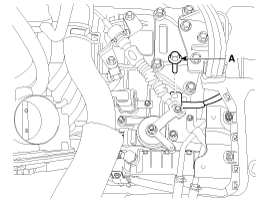
|
| 5. |
Dissconnect the solenoid valve connector (A) and inhibitor switch connector (B). 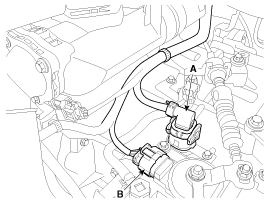
|
| 6. |
Remove the control cable (C) after removing the nut (A) and the bolt (B).
Tightening torque:
(A) 7.8 ~ 11.8 N.m (0.8 ~ 1.2 kgf.m, 5.8 ~ 8.7 lb-ft)
(B) 14.7 ~ 21.6 N.m (1.5 ~ 2.2 kgf.m, 10.9 ~15.9 lb-ft)
|
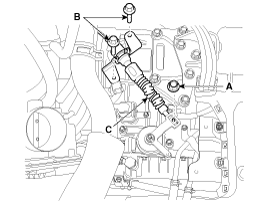
|
| 7. |
Disconnect the clip (A) from the automatic transaxle. 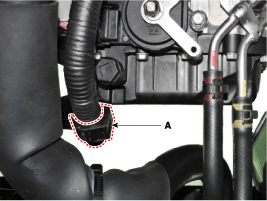
|
| 8. |
Remove the wiring mounting bracket bolt (A). 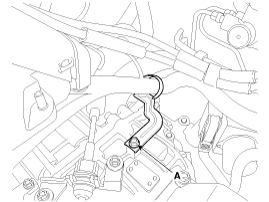
|
| 9. |
Disconnect the hose (B) after removing the automatic transaxle fluid cooler hose clamp (A). 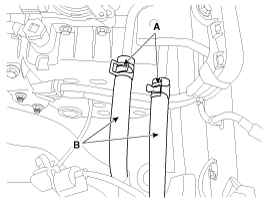
|
| 10. |
Remove the automatic transaxle upper mounting bolt (A-2ea) and the starter motor mounting bolt (B-2ea).
Tightening torque:
(A) 42.2 ~ 54.0 N.m (4.3 ~5.5 kgf.m, 31.1 ~ 39.8 lb-ft)
(B) 49.0 ~ 63.7 N.m (5.0 ~6.5 kgf.m, 36.2 ~ 47.0 lb-ft)
|
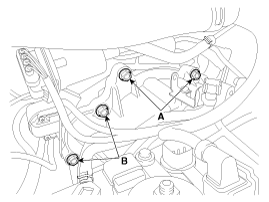
|
| 11. |
Remove the cowl top cover and wiper motor.
(Refer to Body Electrical System - "Windshield Wiper/Washer") |
| 12. |
Remove the cowl complete assembly panel (A). 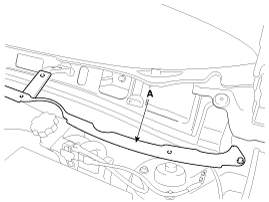
|
| 13. |
After loosening the mounting clips (A), then disconnect the fender side cover (B). 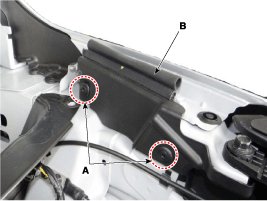
|
| 14. |
Using the engine support fixture (Support SST No.:
09200-2S000, Beam SST No.: 09200-38001), hold the engine and transaxle
assembly safely. 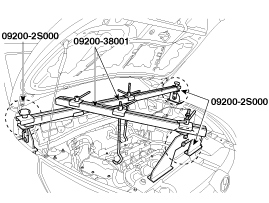
|
| 15. |
Remove the mounting bracket cover (A). 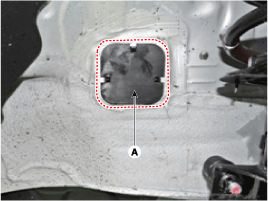
|
| 16. |
Remove the automatic transaxle mounting bracket bolt (A).
Tightening torque :
88.3 ~ 107.9 N.m (9.0 ~ 11.0 kgf.m, 65.1 ~ 79.6 lb-ft)
|
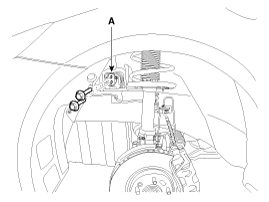
|
| 17. |
Remove the automatic transaxle mounting support bracket (A).
Tightening torque :
58.8 ~ 78.5 N.m (6.0 ~ 8.0 kgf.m, 43.4 ~ 57.9 lb-ft)
|
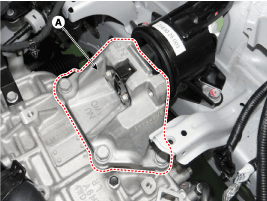
|
| 18. |
Remove the under cover (A).
Tightening torque :
19.6 ~ 24.5 N.m (2.0 ~ 2.5 kgf.m, 14.5 ~ 18.1 lb-ft)
|
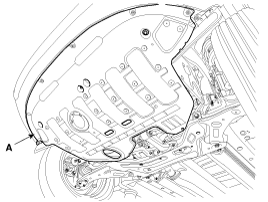
|
| 19. |
Remove the side cover (A). 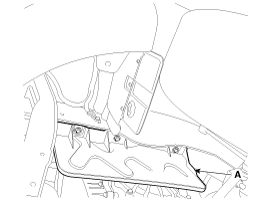
|
| 20. |
Remove the air guard (A) after removing the bolts. 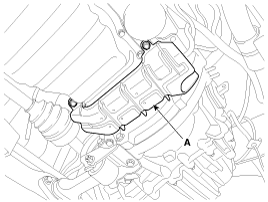
|
| 21. |
Remove the following items;
2WD
| A. |
Drive shaft assembly.
(Refer to Driveshaft and axle - "Drive shaft assembly") |
| B. |
Remove the roll rod support bracket (C) after removing bolt (A,B). |
Tightening torque :
(A) 49.0 ~ 63.7 N.m (5.0 ~ 6.5 kgf.m, 36.2 ~ 47.0 lb-ft)
(B) 107.9 ~ 127.5 N.m (11 ~ 13 kgf.m, 79.6 ~ 94.1 lb-ft)
|
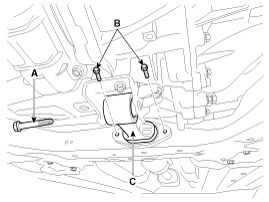
4WD
| A. |
Sub frame assembly.
(Refer to Suspension System - "Sub Frame") |
| B. |
Drive shaft assembly.
(Refer to Driveshaft and axle - "Drive shaft assembly") |
| C. |
Transfer assembly.
(Refer to Transfer system - "Transfer assembly") |
|
| 22. |
Remove the dust cover (A).
Tightening torque :
42.2 ~ 48.1 N.m (4.3 ~ 4.9 kgf.m, 31.1 ~ 35.4 lb-ft)
|
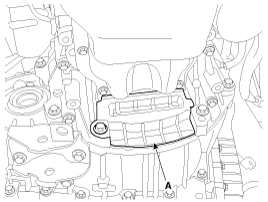
|
| 23. |
Remove the torque converter mounting bolt (A-4ea) with rotating the crankshaft.
Tightening torque:
45.1 ~ 52.0 N.m (4.6 ~ 5.3 kgf.m, 33.3 ~ 38.3 lb-ft)
|
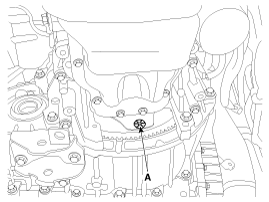
|
| 24. |
Remove the automatic transaxle with a jack after removing the mounting bolt (A-1ea, B-3ea).
Tightening torque:
(A) 42.2 ~ 54.0 N.m (4.3 ~ 5.5 kgf.m, 31.1 ~ 39.8 lb-ft)
(B) 42.2 ~ 48.1 N.m (4.3 ~ 4.9 kgf.m, 31.1 ~ 35.4 lb-ft)
|
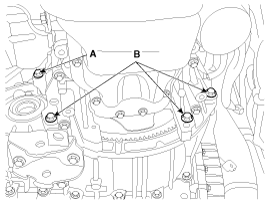
|
| 1. |
Install in the reverse order of removal.
|
Follow the separted each procedure as below according to reinstallation or replacing with a new automatic transaxle. |
|
| 2. |
In case of the reinstallation.
| (1) |
Replace the oil seal with a new one when ATF leak occurred because of differential oil seal damage.
|
When installing the new oil seal, use the special service tool(SST No.:09453-3L241, 09231-H1100). |
|
| (2) |
Check the ATF level after refilling the automatic transaxle with fluid. (Refer to Hydraulic System - "Fluid") |
| (3) |
Clear the diagnostic trouble codes (DTC) using the GDS.
|
Even though disconnecting the battery negative terminal, the
DTCs will not be cleared. So, be sure to clear the DTCs using the GDS. |
|
|
| 3. |
In case of the replacing with a new automatic transaxle.
|
New automatic transaxle is already filled with specified quantity ATF.
For that reason, it does not necessary to refill and check
the ATF but the remaining ATF inside of ATF cooler have to be removed. |
| (1) |
Set the air blow gun in front of the ATF cooler hose (A). |
| (2) |
Remove the remaining ATF by blowing air into ATF cooler hose (A). |
| (3) |
Install the ATF cooler hose (A) and (B). 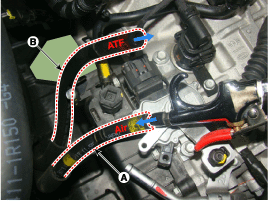
|
| (4) |
Clear the diagnostic trouble codes (DTC) using the GDS.
|
Even though disconnecting the battery negative terminal, the
DTCs will not be cleared. So, be sure to clear the DTCs using the GDS. |
|
| (5) |
Reset the automatic transaxle adaptive values using the GDS. 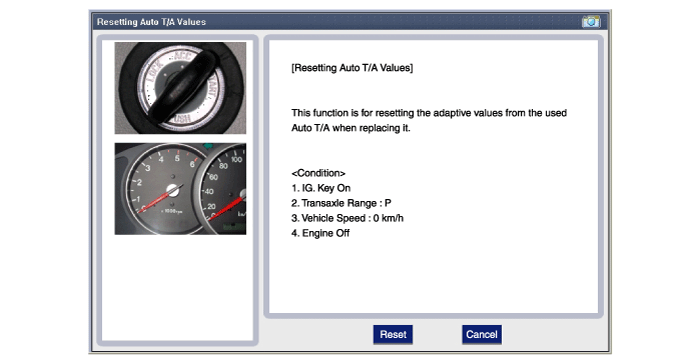
|
| (6) |
Perform the TCM adaptive values learning procedure.
(Refer to Automatic Transaxle Control System - "Repair procedures") |
|
| 4. |
In case of the replacing with a remanufactured automatic transaxle.
|
Remanufactured automatic transaxle is not filled with specified quantity ATF.
For that reason, it is necessary to refill and check the ATF. |
| (1) |
Check the ATF level after refilling the automatic transaxle with fluid. (Refer to Hydraulic System - "Fluid") |
| (2) |
Clear the diagnostic trouble codes (DTC) using the GDS.
|
Even though disconnecting the battery negative terminal, the
DTCs will not be cleared. So, be sure to clear the DTCs using the GDS. |
|
| (3) |
Reset the automatic transaxle adaptive values using the GDS. 
|
| (4) |
Perform the TCM adaptive values learning procedure.
(Refer to Automatic Transaxle Control System - "Repair procedures") |
|
Components Location
1. Automatic transaxle assembly2. Shift cable bracket3. Automatice transaxle mounting support bracket4. Rear cover5. Valve body cover6. Manual control lever7. Air breather hos ...
 Automatic Transaxle Components and Components Location
Automatic Transaxle Components and Components Location Hydraulic System
Hydraulic System























